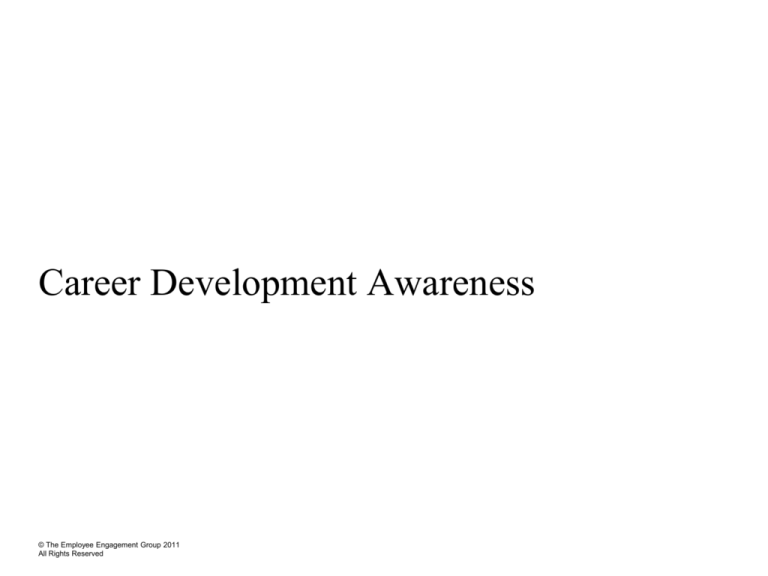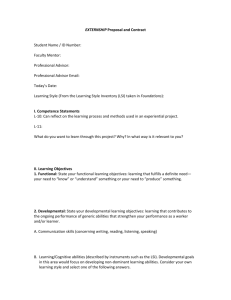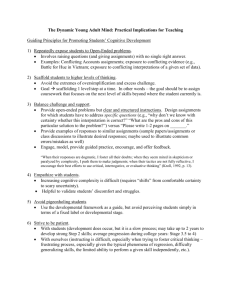
Career Development Awareness
© The Employee Engagement Group 2011
All Rights Reserved
Agenda
Time
00:00
00:00
00:00
00:00
00:00
00:00
00:00
© The Employee Engagement Group 2011
All Rights Reserved
Topic
Introductions
Topic title
Topic title
Topic title
Topic title
Topic title
End of Session
Workshop Objectives
At the end of this training…
– [objective #1]
© The Employee Engagement Group 2011
All Rights Reserved
Career Development Awareness Training
Goals:
– Introduce vertical and lattice career tracks
– Introduce the benefits of job realignment and job
enrichment
– Emphasize career movement based on performance
and potential, vs. longevity and entitlement
– Provide ideas for driving your own career development
– Increase understanding of different ways to learn and
develop yourself
© The Employee Engagement Group 2011
All Rights Reserved
Overview
–
–
–
–
–
–
Define employee profile
Define vertical and lattice paths
Define job enrichment assignments
Define job realignment options
Discuss classification hierarchy
Review steps to identify your career goals and
developmental needs
– Discuss internal and external learning and development
opportunities
– Take responsibility! Next steps
© The Employee Engagement Group 2011
All Rights Reserved
Employee B.E.S.T. Profile
Behaviors/Traits
Experience/Skills
– How we interact with others
– Technical, professional,
business, interpersonal, and
leadership
– Values/Motivators
– Can be encouraged/
discouraged
– Can be learned/
developed
– Personality characteristics
– On-the-job assignments,
coaching, & training are
essential
Easier to see
and develop
Harder to see
and develop
– Work, management and
leadership styles
Skill
Knowledge
Self-Image
Trait
Motive
© The Employee Engagement Group 2011
All Rights Reserved
Necessary for
top performance
but not sufficient
Characteristics
that lead to
longer-term
success
Option 1 - Vertical Movement
Responsibility
Primary Role
Relationship
Level III
− Shapes organizational direction
–
Director
–
Assumes responsibility
for the organization
–
Strategist
–
Business developer
–
Manager
–
Assumes responsibility
for others
–
Integrator
–
Mentor
–
Business developer
–
Assistant
–
“Mentee”
–
Dependence
–
Individual contributor
–
Independence
Level II
– Develops others
– Interfaces
Level I
– Performs tasks under
supervision
– Establishes distinctive
competence
© The Employee Engagement Group 2011
All Rights Reserved
Option 2 – Lattice Career Track
– More flat organizational structure
is decreasing number of high
level managerial positions
– Change in position, but not
necessarily a change in money
or status
– Increases your:
• breadth of knowledge and skills
• marketability
• job satisfaction
© The Employee Engagement
Group 2011 All Rights Reserved
Career Lattice Model
Company Level
Project &
Program Mgt.
Technical
Line
Other
Business
Lines
© The Employee Engagement Group 2011
All Rights Reserved
Sales &
Marketing
Administrative
Career Lattice Model
Technical/Project Management
[division]
[division]
© The Employee Engagement Group 2011
All Rights Reserved
[division]
[division]
[division]
Option 3 - Job Realignment
– Movement can be reversed
– Lessens responsibility
– Increases utilization of your
interests
– Relieves stress
– Career re-direction: weigh job
satisfaction against loss in
status and/or money
– Real success is being satisfied
in one’s job
© The Employee Engagement Group 2011
All Rights Reserved
Life can only be
understood
backwards, but
it must be lived
forwards.
Soren
Kierkegaard
Option 4 - Job Enrichment
– Enhance/diversify your present position
– Most job responsibilities can be flexible
– Most appropriate for those who want to grow in
present position and those who are losing job
satisfaction
– Well-rounded employees make the company
more flexible and responsive to client needs
© The Employee Engagement Group 2011
All Rights Reserved
Job Movement
Option
1
2
Movement
Vertical
“Lattice”
3
Job Realignment
4
Job Enrichment
© The Employee Engagement Group 2011
All Rights Reserved
Which bucket do you fall into?
As you think about your own career development, which best
describes you…
1
Know what I
want to do
Not sure how
to get what I
want
© The Employee Engagement Group 2011
All Rights Reserved
2
3
4
Have some
idea of what I
want to do
Don’t really
know what I
want to do
?
Not sure of the
options
available
Not sure how
to figure it out
Developmental Planning Process
Assess Interests & Competencies: Identify G.A.P.S.
Select Priority Development Goals
Choose 3-4 Development Strategies
Challenging
Assignments
Learning from
Others
Implement Plan
Extract Learning from
Experiences
© The Employee Engagement Group 2011 All Rights Reserved
Training &
Reading
Assess Interests and Competencies
Complete a G.A.P.S. Analysis:
1. Identify your short-term and
longer-term career interests
and Goals
2. Assess your Abilities
3. Get information about how
others see you--their
Perceptions
4. Find out what the Success
Factors are for the position/
job/career that you are
interested in pursuing
© The Employee Engagement Group 2011 All Rights Reserved
Where You are Now
Abilities: What
You Can Do
Perceptions:
How Others See
You
Where You Want to Go
Goals: What
You Want to
Do
Success
Factors: What
Others Expect
Your
view
Others’
view
Know Thyself
Where You are Now
Abilities: What You Can Do
Goals
Abilities
Perceptions
Success
Where You Want to Go
Goals: What You Want to Do
Assess what knowledge, skills,
competencies you have and the
different ways you can apply them.
Think about what is important to you at
work and in the rest of your life, as well
as why those things are important.
Look objectively at your skills in
situations where you have and have
not been as successful.
What do you want to do in the future?
Your
view
Factors
Perceptions: How Others See You
Success Factors: What Others Expect
Others’ observations and how they
interpret them can differ from your own
perceptions and intentions.
Find out what the organizational and
position requirements are for the job
you’re interested in.
A full picture of yourself should include
a view through other lenses; ask for
feedback from multiple sources. Start
with your manager.
Determine what criteria you would need to
meet to get the job, and what would be
expected of you once in the job.
© The Employee Engagement Group 2011
All Rights Reserved
Others
’ view
G.A.P.S. Example
Where Kris Is Now
Abilities:
• Bright, motivated, hard-working.
• Strong project management, communication,
and problem-solving.
• Solid in strategic thinking and people skills.
• Need better business acumen, experience
leading teams, and influencing peers and sr.
mgmt.
Perceptions:
• A talented project manager who has a
reasonable understanding of the business
and competitive forces shaping the industry.
• Not yet a powerful leader; tends to let her
mgmt set the direction rather than
articulating and supporting her own point of
view.
• Modest impact and lack of cross functional
experience have kept her out of
consideration for a DM job.
© The Employee Engagement Group 2011
All Rights Reserved
Where Kris Wants to Go
Goals:
• Become a section manager.
• Longer-term, become a department
manager.
• Have more autonomy and decision-making
authority.
• Use people skills and experience to foster
a thriving, creative atmosphere within the
team.
Kris’
view
Success Factors:
Department managers need to:
• Be independent thinkers who can make
good business decisions in the face of
ambiguity
• Understand and address the issues facing
the business
• Provide strong leadership, especially in
terms of building teams, engaging staff, and
working through others to achieve goals.
Others’
view
“How can you get very far,
If you don’t know Who You Are?
How can you do what you ought,
If you don’t know What You’ve Got?
And if you don’t know Which To Do,
Of all the things in front of you,
Then what you’ll have when you’re through,
Is just a mess without a clue
Of all the best that can come true
If you know What, and Which, and Who.”
- Benjamin Hoff, The Tao of Pooh
© The Employee Engagement Group 2011
All Rights Reserved
Values and Work
– Jobs inherently are neither satisfying or
unsatisfying
– It’s the fit between the job characteristics
and your personal values that determines
how satisfying it is
© The Employee Engagement Group 2011
All Rights Reserved
Where You are Now
Goals: What
You Want to
Do
Your
view
Work Values Worksheet
– What characteristics of a job or work assignment do you
particularly like or dislike?
• Complete the worksheet, which can be found on the
intranet: Training site, Core Skills, Career Path Awareness
• Discuss with your manager
© The Employee Engagement Group 2011
All Rights Reserved
Success Factors
– Identify 2-3 jobs you are
interested in possibly pursuing as
a next position or longer-term
career
Where You Want to Go
Success
Factors: What
Others Expect
• Identify what you think are the:
– Critical skill/knowledge and experience
requirements
– Key behaviors & traits
– Talk to 1-2 people who are
currently doing the job(s) you’re
interested in
• Confirm what the success factors are
© The Employee Engagement Group 2011
All Rights Reserved
Skill
Knowledge
Self-Image
Trait
Motive
Others’
view
Abilities & Perceptions
– Take a few minutes to jot down
• What you consider to be your top 3 strengths
• What you think are your top 3 improvement
areas
Where You are Now
Abilities: What
You Can Do
Your
view
– What you need to learn
– Skills that need further development
– Partner with someone who has the
opportunity to observe you at work
• Share your self-assessment
• Ask for feedback/perceptions
– What do I do well?
– What might I do differently to improve?
© The Employee Engagement Group 2011
All Rights Reserved
Perceptions:
How Others See
You
Others’
view
Developmental Planning Process
Assess Interests & Competencies: Identify G.A.P.S.
Select Priority Development Goals
Choose 3-4 Development Strategies
Challenging
Assignments
Learning from
Others
Implement Plan
Extract Learning from
Experiences
© The Employee Engagement Group 2011 All Rights Reserved
Training &
Reading
Select Priority Development Goals
– Discipline yourself to focus on
one or two
– Select those that are important to
both you and the company
– Make them specific enough to
translate into action
– Stay the course; don’t get
distracted from your mission
– Expect them to evolve over time
© The Employee Engagement Group 2011 All Rights Reserved
Developmental Planning Process
Assess Interests & Competencies: Identify G.A.P.S.
Select Priority Development Goals
Choose 3-4 Development Strategies
Challenging
Assignments
Learning from
Others
Implement Plan
Extract Learning from
Experiences
© The Employee Engagement Group 2011 All Rights Reserved
Training &
Reading
Choose Development Strategies
Challenging
Assignments
© The Employee Engagement Group 2011
All Rights Reserved
– Added scope/responsibility/
authority within current job
– New job
– Temporary assignment
– Developing/Starting something
from scratch
– Fixing an existing problem
– Line to Staff
– Projects
– Task forces
– High visibility/pressure
Choose Development Strategies (cont’d.)
Learning from
Others
– Internal Feedback
• Supervisor
– Ongoing throughout year
– Employee evaluation
© The Employee Engagement Group 2011
All Rights Reserved
• Technical/Service Line/Industry
Leaders
• Peers
• Direct reports
• Mentor
– External feedback
• Clients (can be internal in support
services role)
Choose Development Strategies (cont’d.)
Learning from
Others
© The Employee Engagement Group 2011
All Rights Reserved
– Partner with someone more
senior on a project
– Observations/mentoring
– New Boss
– Role model/coach
– Professional/Subject Matter
Experts
Choose Development Strategies (cont’d)
Training &
Reading
– Internal Training/Development
• Corporate training
• Brown bag seminars
• Company driven (e.g. project management
training)
• Self-directed learning tools - videos, computerbased training (internet), webinars
• Breakfast and lunch seminars
– External Training/Development
© The Employee Engagement Group 2011
All Rights Reserved
•
•
•
•
•
Seminars
Conferences
Accredited college/university courses
Professional licensing/certification
Professional associations/networking groups
Developmental Planning Process
Assess Interests & Competencies: Identify G.A.P.S.
Select Priority Development Goals
Choose 3-4 Development Strategies
Challenging
Assignments
Learning from
Others
Implement Plan
Extract Learning from
Experiences
© The Employee Engagement Group 2011 All Rights Reserved
Training &
Reading
Implementing Your Plan
– Stretch your comfort zone
– Chip away at your plan; invest daily
in your learning and development
– Be opportunistic
– Be optimistic
– Face your barriers
– Reflect on learning
• What did I do well?
• What can I do differently next time?
– Get feedback and support
© The Employee Engagement Group 2011
All Rights Reserved
Expand Your
Comfort Zone
Your Manager’s Role
At an individual level
– Cultivate insight into G.A.P.S.
•
•
Feedback on strengths and weaknesses
Current and emerging company needs, success
factors
– Share ideas about competencies that are
most important
•
•
For different positions and career paths
Today & in the future
– Encourage commitment to 1-2 focused
priority goals
– Set realistic expectations about available
development support
– Create new ways for people to “stretch” and
develop skills
– Link people with resources and support
© The Employee Engagement Group
2011 All Rights Reserved
Your Manager’s Role
At a company level
– Examine current and future
staffing requirements – identify voids
– Inventory current employees’ strengths and developmental
needs (in relationship to above position requirements)
– Identify appropriate developmental opportunities (training,
assignments, etc.) to “groom” successor candidates
– Emphasize development in business planning and
evaluation process
– Recognize people who develop themselves and others
© The Employee Engagement
Group 2011 All Rights Reserved
Conclusion
– Your career path is a choice, not a given
– This is a road map - you choose the route and
destination
– Take every opportunity to ensure your supervisor is
aware of your career intentions so you can jointly chart
an appropriate path – it is a mutual responsibility
Charge # for this Webinar: 99895-031-802
© The Employee Engagement Group 2011
All Rights Reserved
Questions?
© The Employee Engagement Group 2011
All Rights Reserved
Thank You
© The Employee Engagement Group 2011
All Rights Reserved






